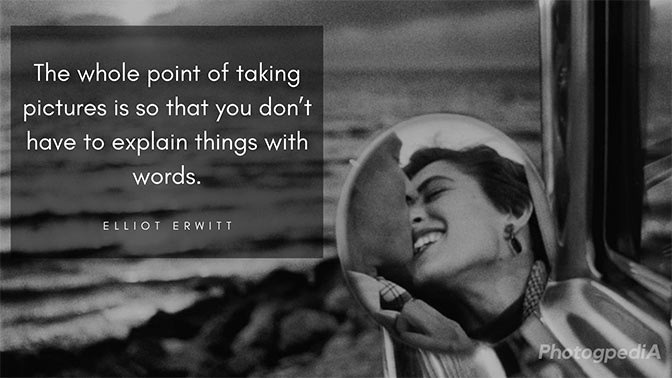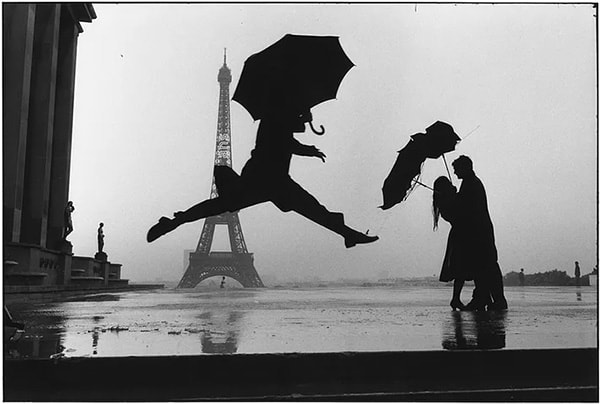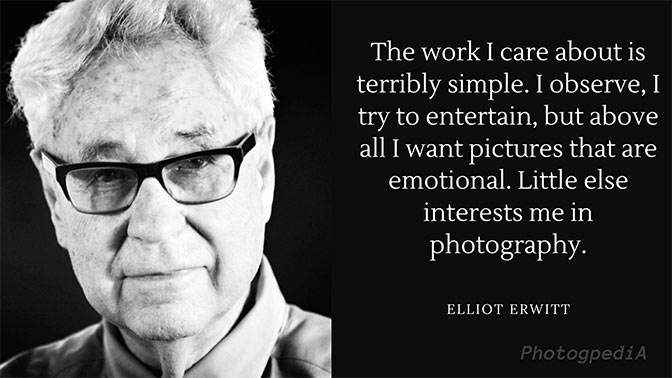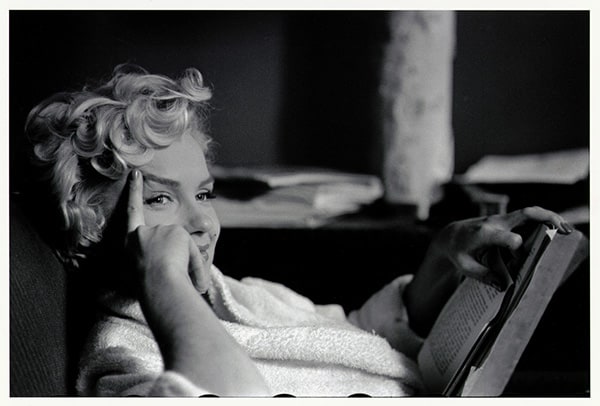Looking for the best Elliot Erwitt quotes? Then you’ve come to the right place. Below we’ve listed our favorite quotes from one of the masters of street photography to inspire and help take your photography to the next level.
Elliot Erwitt Quotes
A picture should be looked at – not talked about.
Photography is a craft. Anyone can learn a craft with normal intelligence and application. To take it beyond the craft is something else. That’s when magic comes in. And I don’t know that there’s any explanation for that.
What I like in any – young, old, middle-aged, doesn’t matter – photographers is a sense that they are interested in the human comedy, you might say, [and] that the pictures are good technically – by that I mean, good composition, good content. Unfortunately, now taking pictures has become so easy that everyone on Earth who has a telephone is a photographer. Consequently the work is generally a bit shoddy, because it’s so easy. Somehow Photoshop and the ease with which one can produce an image has degraded the quality of photography in general. Still, there are very good photographers among the masses.
I don’t like explosions. I don’t mind progress. But digital photography has made every man, woman, child and chimpanzee a photographer of sorts and consequently has numbed down the general quality of photographs.
The whole point of taking pictures is so that you don’t have to explain things with words.

Erwitt on the Work
Do what the client wants, not what you want.
No matter how boring a job, it’s a success if he’s been able to get one picture for himself.
I don’t believe that photography can change the world, but it can show the world changing.
Now very often events are set up for photographers… The weddings are orchestrated about the photographers taking the picture, because if it hasn’t been photographed it doesn’t really exist.
I wasn’t imposing my presence on anyone,… which is very important for a would-be journalist. I stayed back. Always let people be themselves.
Making books is a very specific kind of activity. It’s not really a collection of your best pictures – although it is – but it’s also a way of presenting your work so that it’s not repetitive, so that it flows, and so that it makes sense in a book.
I am unspecialized in a very specialized profession. Some commercial clients aren’t quite sure how to take me. Some probably think I’m dead because I’ve been around so long.
Working myself into a position of total versatility, so that I can do anything I want to do at the time I want to do it. Whether I do it or not is another question.
On Success
You don’t study photography, you just do it.
[A Photographer needs:] creativity, style, elegance, wit and craft. [A photojournalist also needs that and] courage, stamina, cunning and luck.
If you’ve got no responsibility and don’t have to generate a certain amount of cash each month, and can live on a shoestring, and are ambitious enough, then you might have a chance. You can be dedicated but that is no guarantee that you’ll make it. I rely on a hunch, little luck, and some cunning.
There are so many fine photographers who are underrated that it would be unfair to name just one. Look at the New York Times, where the quality of photography has so leaped forward – these are not known photographers, they’re just workaday photographers who take wonderful pictures. Recognition comes as a result of luck, timing and the situation at large.
You have to devote yourself totally to be successful at it.
Elliot Erwitt Quotes on Technique
There isn’t much to learn about photography, everything you need to know you can find out by reading the instructions in the box. The rest is practise.
Maybe this should be a secret: photography is a lazy man’s profession. You don’t have to train, like a musician or a doctor or a ballet dancer. You only need the modest ability to achieve order and composition, or find the right balance of mood.
Good photography is not about ‘Zone Printing’ or any other Ansel Adams nonsense. It’s just about seeing. You either see, or you don’t see. The rest is academic. Photography is simply a function of noticing things. Nothing more.
Quality doesn’t mean deep blacks and whatever tonal range. That’s not quality, that’s a kind of quality. The pictures of Robert Frank might strike someone as being sloppy–the tone range isn’t right and things like that–but they’re far superior to the pictures of Ansel Adams with regard to quality, because the quality of Ansel Adams, if I may say so, is essentially the quality of a postcard. But the quality of Robert Frank is a quality that has something to do with what he’s doing, what his mind is. It’s not balancing out the sky to the sand and so forth. It’s got to do with intention.
I think if you’re going to take a picture, you need visual sense. Unless you take photos of your cat, dog, or child as a memento. If you’re serious of taking photos, you should study the classic arts to speak – you need a visual sense of composition. I think you should find substance in your pictures. Meaning, content. If you’re lucky and you do something that is graphically interesting like content – and there is a little magic on top of it, perhaps you have a picture
I dislike landscapes. I only like people, and plastic flowers.
[Yousef Karsh] thoroughly researches his subject, knows wife’s name, or man’s hobby, and uses this information to the hilt. He’s the ultimate flatterer.
Photoshop is useful in many ways but must never be used for the altering of photographs. My assistants and my agency do whatever Photoshop work for me that may be required as it is too complicated for my brain.
Balance of light is the problem, not the amount. Balance between shadows and highlights determines where the emphasis goes in the picture… make sure the major light in a picture falls at right angles to the camera.

The Art of Observation and Simplicity
Photography is pretty simple stuff. You just react to what you see, and take many, many pictures.
All the technique in the world doesn’t compensate for the inability to notice.
To me, photography is an art of observation. It’s about finding something interesting in an ordinary place… I’ve found it has little to do with the things you see and everything to do with the way you see them.
It’s just seeing – at least the photography I care about. You either see or you don’t see. The rest is academic. Anyone can learn how to develop. It’s how you organize what you see into a picture.
My ‘work’ is about seeing not about ideas.
Something catches your eye, or your interest. You attack it in some way or observe it in some way, and try to put it in some kind of form and take a picture. It’s as simple as that.
I like things that have to do with what is real, elegant, well presented and without excessive style. In other words, just fine observation.
I rarely stage pictures. I wait for them… let them take their own time. Sometimes, you think something’s going to happen, so you wait. It may pan out; it may not. That’s a wonderful thing about pictures– things can happen. It’s not that I’m against staging, or anything else, when you’re not cheating or working with false purposes. Even as you wait, you are, in a way, arranging and manipulating. You’re getting ready to frame the event, when it happens, the way you want it to be framed. Maybe I’m contradicting myself. Well, okay.
Making people laugh is one of the highest achievements you can have. And when you can makesomeone laugh and cry, alternately, as Chaplin does, now that’s the highest of all possible achievements. I don’t know that I am for it, but I recognize it as the supreme goal.
Unfortunately, most people are insecure about judging or reacting to pictures. They gravitate toward what’s familiar, established, safe. That’s true even of some ‘experts,’ editors who are paid to read contact sheets and pick occasional good pictures out of a whole mass of lousy ones. They don’t know how to look. Or they’re unsure of what they see. But it’s just as true that there are ordinary, non-sophisticated people who often are unusually insightful about visual things.
The work I care about is terribly simple. I observe, I try to entertain, but above all I want pictures that are emotional. Little else interests me in photography. Today, so much is being done by unemotional people, or at least it looks that way… I mean, work that’s fascinating and fun and clever and technically brilliant. But if it’s not personal, then it misses what interesting photography is about.

Elliot Erwitt Quotes for Better Photography
Making pictures is a very simple act. There is no great secret in photography… schools are a bunch of crap. You just need practice and application of what you’ve learned. My absolute conviction is that if you are working reasonably well the only important thing is to keep shooting… it doesn’t matter whether you are making money or not. Keep working, because as you go through the process of working things begin to happen.
Be sure to take the lens cap off before photographing.
If you keep your cool, you’ll get everything.
When you go out into the field with your camera, wear a jacket with big pockets, LOTS of big pockets.
After following the crowd for a while, I’d then go 180 degrees in the exact opposite direction. It always worked for me, but then again, I’m very lucky.
The ratio of successful shots is one in God-knows-how-many. Sometimes you’ll get several in one contact sheet, and sometimes it’s none for days. But as long as you go on taking pictures, you’re likely to get a good one at some point.
I don’t think you can create luck. You’re either lucky or you’re not. I don’t know if it’s really luck or if it’s just curiosity. I think the main ingredient, or a main ingredient for photography is curiosity. If you’re curious enough and if you get up in the morning and go out and take pictures, you’re likely to be more lucky than if you just stay at home.
Finding your Photos
Nothing happens when you sit at home. I always make it a point to carry a camera with me at all times… I just shoot at what interests me at that moment.
When I get up in the morning I brush my teeth and go about my business, and if I’m going anywhere interesting I take my camera along.
You can find pictures anywhere. It’s simply a matter of noticing things and organizing them. You just have to care about what’s around you and have a concern with humanity and the human comedy.
Being shy is quite useful to a photographer, because it gives you the opportunity of not being shy once you have the field of a camera before you. It protects you from being shy.
The thing is that when you don’t carry a camera, that’s when you see pictures in particular, or at least that’s when you think you see pictures in particular. When you do carry it, if you do see one on the occasion that you do, you can take it.
I don’t think when I’m taking a photograph. What I love best is spontaneity.
I like dogs… They’re sympathetic. They’re nice. They don’t ask for prints.

Erwitt on Amateur Photography
It’s about time we started to take photography seriously and treat it as a hobby.
I’m an amateur photographer, apart from being a professional one, and I think maybe my amateur pictures are the better ones.
I’ll always be an amateur photographer.
I’m not a serious photographer like many of my contemporaries. That is to say, I am serious about not being serious.
I am a professional photographer by trade and an amateur photographer by vocation.
Cameras and Film Photography
My first serious camera was a Rolleiflex. I used it for quite some time, until I got tired of the square format which is not really terribly suitable to the kind of pictures that I was interested in. Also it’s a camera that you don’t use up to the eye but to the stomach, and I always think it’s better to look at what you’re photographing through your eyes rather than through your stomach.
There’s a profound difference between the simple non-reflex, direct-viewing camera (such as a range-finder Leica) and a SLR. With a reflex you tend to make the picture in the camera; with the other, you see the picture and then put a frame around it. The RF camera is also faster, quicker to focus, less noisy, and smaller, but these advantages are much less important than the fundamental difference.
I use the rectangular format because the proportion of 1 to 1 1/2, close to the “golden section”, seems particularly right. In almost everything, including architecture, it’s more pleasing to the eye. It’s also the the 35mm format, of course.
Black and White Photography
[on Black and White] It looks better. I have more control and everything is out of my darkroom. I work with a printer and supervise everything…When I take pictures for my own amusement, it’s black and white… for professional work, I don’t care.
I don’t keep color pictures for my ‘personal exposures.’ Color is for work. My life is already too complicated, so I stick to black-and-white. It’s enough. Black-and-white is what you boil down to get the essentials; it’s much more difficult to get right. Color works best for information.
Color is descriptive. Black and white is interpretive.

What Camera Does Elliot Erwitt Use?
Erwitt started out with a Rolleiflex. In the ’50s, he made the switch Leica and hasn’t looked back.
He began with the Leica IIIf and IIIg, then moved on to the Leica M3. He continues to use the M3 today, along with other Leica M bodies. Erwitt has also used Canon F1 and EOS 35mm cameras as well as 6×9 medium format too.
Like other great photographers including his mentor Robert Capa, Erwitt’s prefered lens is a 50mm. He also occassionally uses a 90mm.
Erwitt shoots digital cameras for most of his professional work today. For personal projects, he uses 35mm film.
Simplicity. I have a large arsenal of equipment for my professional work, but for my informal pictures I mostly use a 50-mm lens, sometimes a 90-mm. I work within a narrow range. I like to work with only one kind of film at a time, because I get confused easily. When I mix films, I often make a mistake and shoot with the wrong one. Tri-X is the most useful to me. I don’t like to make tests. I like for other photographers to make the tests and give me the results. I believe them.
What’s your Favorite Elliot Erwitt Quote?
Have a favorite Elliot Erwitt quote from the list? Let us know in the comment section below.
Don’t forget to bookmark this page, or print it out, and refer to it next time you need some inspiration. Like the article? Share it with other photographers.
To see more of Erwitt’s brilliant photography, check out the image archive on the Elliot Erwitt website.
Looking for more words of wisdom from master photographers? Visit the quotes section of Photogpedia for more great photography quotes.
Related Quote Articles:

